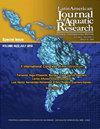Spatiotemporal analysis of the genetic and morphological variation of Iphigenia brasiliensis (Mollusca: Bivalvia) from the southwest tropical Atlantic
IF 0.8
4区 农林科学
Q3 FISHERIES
Latin American Journal of Aquatic Research
Pub Date : 2023-02-28
DOI:10.3856/vol51-issue1-fulltext-2785
引用次数: 0
Abstract
Iphigenia brasiliensis is a bivalve mollusk exploited as a shellfish and subsistence resource on the Brazilian coast, mainly in the north and northeast regions. Genetic (allozyme electrophoresis revealed eight gene loci) and morphological variations (multivariate morphometry of valves used 13 linear measurements of traditional and 19 Fourier coefficients of geometric morphometry) were studied, considering the geographic (445 km of the southwest tropical Atlantic), environmental (mangroves and channels of communication with the sea of three estuaries in the state of Rio de Janeiro), and temporal dimensions (over two years). I. brasiliensis showed high levels of genetic variation (the average number of alleles per locus ranged from 2.8 to 3.4, and the average heterozygosity ranged from 0.441 to 0.675). Bayesian analysis of population partitioning showed that the highest LnP(D) value was achieved for K = 3. These results indicated mixed ancestry, possibly oscillations in the dispersion dynamics among the different sampling groups, and temporal oscillations in the population sizes due to the anthropogenic influence on the studied estuaries. The results of morphological variation, inferred by the PERMANOVA from the Fourier analysis, indicated that a similar influence might occur in valves (also, the discriminant analysis showed that different groups could be consistently identified). In this sense, the studied populations may be organized in a dynamic of metapopulations. Finally, these are the first data on morphological and genetic variation of the species in the latitudinal, environmental, and temporal dimensions studied simultaneously, thus providing relevant information for the exploration, management, and conservation of this commercially important species.热带大西洋西南部巴西伊菲igenia brasiliensis(软体动物:双壳亚目)遗传与形态变异的时空分析
巴西伊菲格尼亚软体动物是一种双壳纲软体动物,主要在巴西北部和东北部地区被用作贝类和生存资源。研究了遗传(等位酶电泳揭示了8个基因位点)和形态变异(瓣膜的多变量形态测量使用了传统形态测量的13个线性测量和几何形态测量的19个傅立叶系数),环境(里约热内卢州三个河口的红树林和与海洋的沟通渠道)和时间维度(两年以上)。巴西I.brasiliensis表现出高水平的遗传变异(每个基因座的平均等位基因数在2.8到3.4之间,平均杂合度在0.441到0.675之间)。群体划分的贝叶斯分析表明,K=3时LnP(D)值最高。这些结果表明了混合祖先,不同采样组之间的分散动力学可能存在振荡,以及由于人为因素对所研究河口的影响而导致的种群规模的时间振荡。PERMANOVA从傅立叶分析推断出的形态学变化结果表明,瓣膜可能会产生类似的影响(此外,判别分析表明,可以一致地识别不同的组)。从这个意义上说,所研究的种群可能是在集合种群的动态中组织起来的。最后,这些是首次同时研究该物种在纬度、环境和时间维度上的形态和遗传变异数据,从而为该商业重要物种的勘探、管理和保护提供了相关信息。
本文章由计算机程序翻译,如有差异,请以英文原文为准。
求助全文
约1分钟内获得全文
求助全文
来源期刊

Latin American Journal of Aquatic Research
FISHERIES-MARINE & FRESHWATER BIOLOGY
CiteScore
1.70
自引率
10.00%
发文量
44
审稿时长
4-8 weeks
期刊介绍:
Latin American Journal of Aquatic Research- LAJAR is the continuation of the journal Investigaciones Marinas (1970-2007) and is published since 2008 by the Escuela de Ciencias del Mar, Facultad de Ciencias del Mar y Geografía of the Pontificia Universidad Católica de Valparaíso. LAJAR is an “Open Access” journal that publishes in English language, original research articles, reviews and short communications on aquatic science, which contain the results of research conducted in aquaculture or in oceanic and coastal marine waters of Latin America.
The following topics are considered: Physical Oceanography, Chemical Oceanography, Marine Biogeochemistry, Marine Pollution and Toxicology, Marine Geology and Geophysics, Biological Oceanography, Fisheries and Aquaculture.
 求助内容:
求助内容: 应助结果提醒方式:
应助结果提醒方式:


